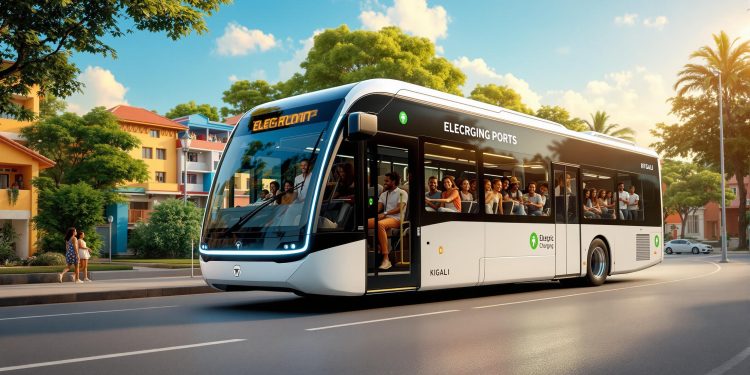Rwanda is working to electrify 20% of its public bus fleet by 2030. This initiative aims to reduce urban air pollution, lower greenhouse gas emissions, and modernize public transportation. The plan includes building EV charging stations, offering government incentives, and replacing diesel buses with electric ones to improve efficiency and reduce costs.
Key Points:
- Goal: Electrify 20% of public buses by 2030.
- Benefits: Cleaner air, reduced emissions, cost savings, and quieter, more reliable buses.
- Challenges: High upfront costs, upgrading power infrastructure, and integrating new systems.
- Solutions: Expanding charging networks, simplifying regulations, and providing financial incentives.
This effort positions Rwanda as a leader in eco-friendly transit in Africa, offering a model for other nations to follow.
Rwanda rolls out electric buses in Kigali
Why Electric Buses Matter
Electric buses bring both environmental improvements and cost savings that go beyond simply replacing traditional vehicles.
Reducing Emissions
Electric buses play a key role in lowering urban air pollution and greenhouse gas emissions. In Kigali, where traffic congestion often impacts air quality, swapping diesel buses for electric ones can lead to cleaner air and a healthier city. These buses don’t emit CO2 from their tailpipes. Plus, as Rwanda increases its renewable energy sources like hydropower and solar, the overall environmental impact of electric buses becomes even more positive.
Economic Advantages
While electric buses come with higher upfront costs, they save money over time through reduced energy and maintenance expenses. These savings make the system more efficient. On top of that, expanding charging infrastructure creates local jobs and cuts down on the need for imported fuel. These combined benefits align with Rwanda’s broader push to modernize public transportation.
How Rwanda Will Reach 20% by 2030
Rwanda aims to electrify 20% of its bus fleet by 2030 through a combination of expanding EV charging infrastructure and implementing supportive government measures. Here’s a closer look at the main components of this plan.
Expanding EV Charging Networks
One of the core elements of the strategy is setting up EV charging stations along key bus routes. The government is working to identify the best locations for fast-charging stations, designed to quickly recharge buses and keep them running efficiently. This focus on building a reliable charging network is essential for transitioning to electric buses without disrupting public transport services.
Policy and Incentive Support
To complement the infrastructure push, the Rwandan government is rolling out policies and incentives aimed at encouraging investment. These include simplifying regulatory procedures and offering financial benefits to attract funding for charging stations and fleet upgrades. These efforts highlight Rwanda’s dedication to creating a cleaner and more efficient public transportation system.
sbb-itb-7bc66b5
Main Hurdles and Solutions
Technical Issues
Rwanda has ambitious plans to expand its charging infrastructure, but several technical challenges stand in the way. One pressing issue is upgrading the EV charging network to support the growing electric bus fleet. The current power infrastructure needs improvements to handle peak electricity demands and maintain a steady power supply. Additionally, integrating this charging infrastructure into the existing transit system is crucial to ensure consistent and dependable service. Tackling these challenges is key to advancing Rwanda’s goal of creating a reliable and modern public transportation system.
What Success Looks Like
Reduced Carbon Emissions
Switching the bus fleet from diesel to electric will help lower greenhouse gas emissions. This change will also improve air quality in Rwanda’s cities, especially in Kigali’s crowded urban areas.
Improved Bus Service
Electric buses are quieter and offer smoother rides, making trips more comfortable for passengers. With fewer parts and less upkeep required, these buses are also more reliable. This means shorter wait times, better service during busy hours, and the possibility of expanding routes. These improvements could help Rwanda raise the bar for public transit in the region.
Setting an Example for Africa
Rwanda’s move to electric buses positions it as a trailblazer in eco-friendly public transport across Africa. By tackling infrastructure challenges and building local expertise, this program could become a model for other countries looking to modernize their transit systems while reducing their environmental footprint.
Conclusion
Rwanda is working toward electrifying 20% of its public buses by 2030, a move that could transform public transportation in East Africa. This plan aims to balance environmental goals with the practical needs of daily transit.
The project’s success depends on several factors. Building a reliable charging network and providing specialized training for drivers and technicians are critical steps. Financial support through government incentives and international partnerships will also play a major role in making this shift economically feasible.
Though challenges like high upfront costs and limited technical expertise remain, Rwanda’s phased approach demonstrates its dedication to improving public transportation. Gradual implementation ensures that the transition is both strategic and manageable.
This initiative not only supports climate goals but also aims to make commuting more efficient and comfortable. By adopting electric buses, Rwanda positions itself as a leader in modernizing public transit across the continent.
Related posts
- Rwanda EV Import Duty Exemptions Explained
- EVs vs. ICE Cars: Performance on Rwanda’s Roads
- Carbon Offsetting in Rwanda: How It Works
- Rwanda’s ICE Vehicles: Carbon Emissions Impact





